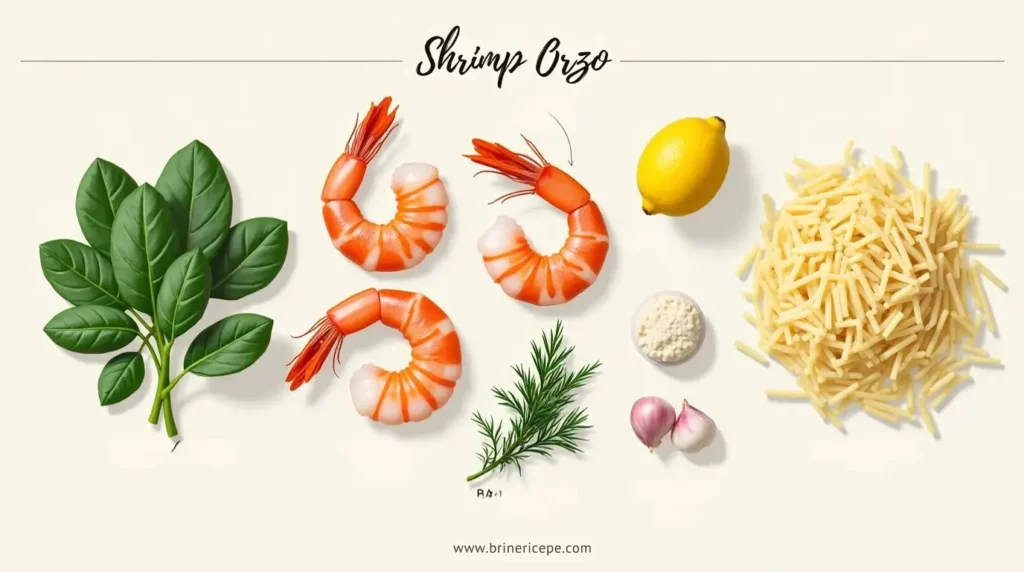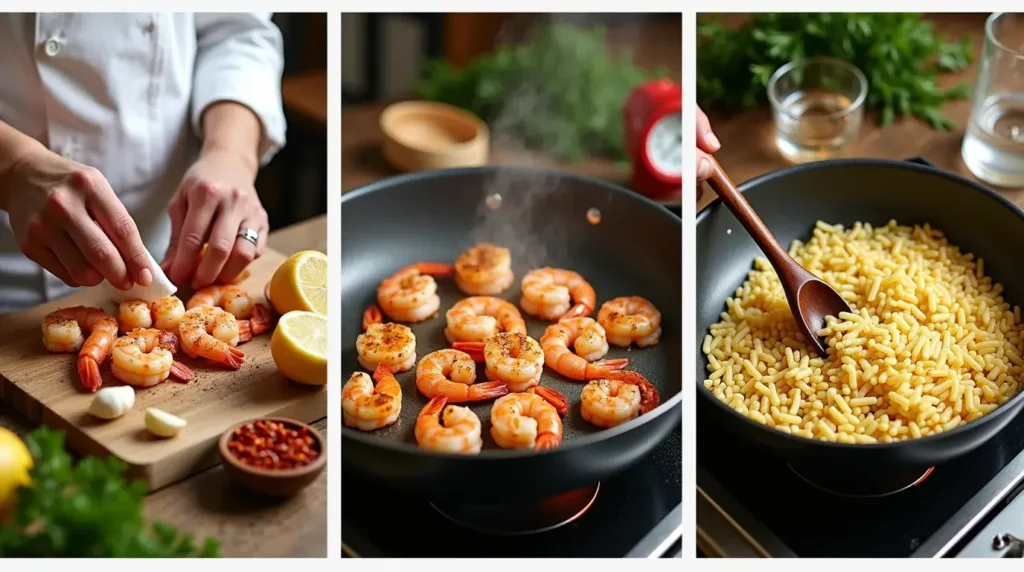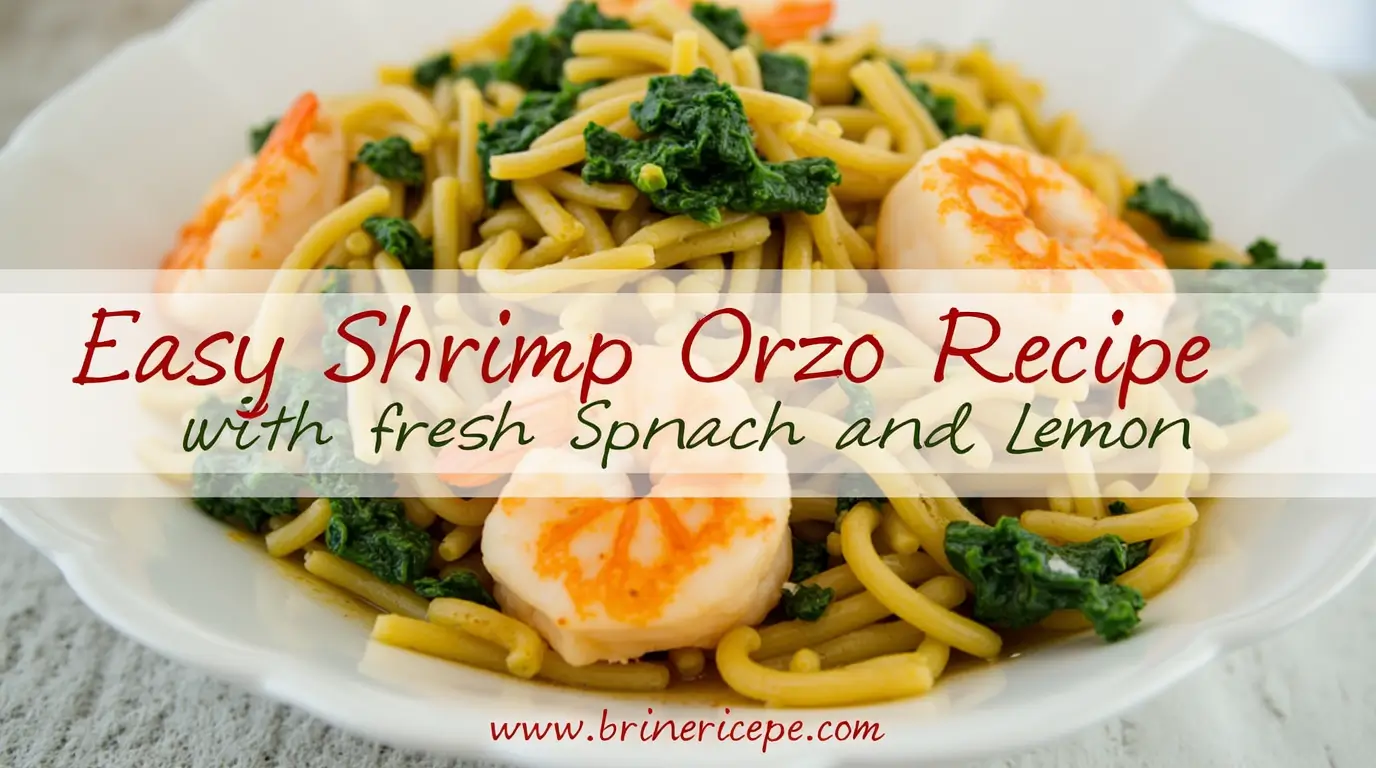Picture yourself savoring a forkful of perfectly cooked orzo pasta, wrapped in a light lemony sauce, accompanied by succulent, garlic-kissed shrimp. That’s the magic of shrimp orzo – a dish that transforms simple ingredients into an elegant yet comforting meal. Whether you’re an experienced home chef or just beginning your culinary journey, this recipe will guide you through creating a restaurant-worthy dish right in your kitchen.
Table of Contents
What is Orzo? Understanding Your Main Ingredient
Ever glanced at orzo in the pasta aisle and wondered about its unique shape? Despite its rice-like appearance, orzo is actually a small pasta variety that originated in Italy. Made from semolina flour, this versatile pasta brings the best of both worlds – the satisfying texture of pasta with the serving versatility of rice. Its compact size allows it to cook quickly while absorbing flavors beautifully, making it perfect for both warm entrées and chilled salads.
Origin and Composition
Traditional Italian orzo, known as “risoni,” carries a rich culinary heritage. While it resembles rice grains, each piece is carefully crafted from durum wheat semolina, giving it that characteristic firm texture that holds up wonderfully in both soups and pasta dishes. Unlike regular pasta, orzo’s small size means it cooks in just 8-10 minutes, perfect for those busy weeknight dinners when time is precious.
Why Choose Orzo?
Your culinary adventures with orzo will reveal its remarkable adaptability. This petit pasta excels in absorbing sauces while maintaining its shape, creating a delightful textural experience in every bite. Its quick cooking time doesn’t sacrifice flavor – instead, orzo readily embraces the seasonings and ingredients it’s paired with, making it an ideal canvas for both bold and subtle flavors.
Essential Ingredients for Your Perfect Shrimp Orzo
Before diving into the cooking process, gather these carefully selected ingredients that will bring your shrimp orzo to life:
| Ingredient | Quantity | Notes |
|---|---|---|
| Large shrimp | 1 pound | Peeled and deveined, tail-on for presentation |
| Orzo pasta | 1½ cups | Choose high-quality for best results |
| Fresh lemon | 2 | Organic preferred for zesting |
| Baby spinach | 3 cups | Fresh, bright green leaves |
| Garlic | 4 cloves | Freshly minced for optimal flavor |
| Feta cheese | ½ cup | Traditional Greek feta recommended |
| Extra virgin olive oil | ¼ cup | Use a good quality oil |
| White wine | ½ cup | Dry variety (optional) |
| Fresh herbs | ¼ cup | Parsley and dill |

Step-by-Step Cooking Guide
Perfecting Your Shrimp
The secret to irresistible shrimp lies in proper preparation and cooking technique. Begin by patting your shrimp completely dry with paper towels – this crucial step ensures a beautiful golden sear rather than a steamed result. Season them generously with salt and freshly ground black pepper, perhaps adding a pinch of red pepper flakes for a subtle heat that complements the lemon and garlic.
Heat your pan until it’s properly hot before adding the shrimp. You’ll know it’s ready when a drop of water dances across the surface. Cook the shrimp for just 2-3 minutes per side until they turn pink with a slightly golden crust. Remember, overcooked shrimp become rubber-like, so keep a close eye on them.

Mastering the Orzo
Your orzo deserves the same attention to detail as your shrimp. Start by toasting it in a dry pan for a minute or two until it develops a light golden color – this simple step adds a nutty depth to your final dish. Cook the orzo in well-salted water, stirring occasionally to prevent sticking. Test it frequently as it approaches the 8-minute mark; you’re aiming for tender but still slightly firm to the bite.
A professional tip: Reserve a cup of the pasta cooking water before draining. This starchy liquid becomes liquid gold when you need to adjust the consistency of your final dish.
Recipe Variations
Mediterranean Style
Transform your shrimp orzo into a Mediterranean feast by incorporating:
- Halved cherry tomatoes for bursts of sweetness
- Kalamata olives for briny depth
- Fresh oregano and thyme
- A generous drizzle of your finest olive oil
- Pine nuts toasted until golden
Creamy Version
Craving something richer? Create a luxurious creamy version by:
- Adding mascarpone or cream cheese
- Incorporating freshly grated Parmesan
- Using heavy cream instead of pasta water
- Including sun-dried tomatoes
- Finishing with a touch of truffle oil
Essential Tips for Success
Elevate your shrimp orzo with these professional insights:
- Always bring shrimp to room temperature before cooking
- Save the pasta water – it’s your secret weapon for the perfect sauce consistency
- Toast the orzo before boiling for enhanced nutty flavors
- Add spinach at the very end to maintain its bright color
- Let the dish rest for 5 minutes before serving to allow flavors to meld
Nutritional Information
| Nutrient | Amount per Serving |
|---|---|
| Calories | 380 |
| Protein | 28g |
| Carbohydrates | 45g |
| Fat | 12g |
| Fiber | 3g |
| Sodium | 580mg |
Frequently Asked Questions
Can I make this recipe dairy-free? Absolutely! Skip the feta and instead add nutritional yeast for a cheesy flavor, or include more Mediterranean ingredients like olives and capers for depth.
How do I store leftover shrimp orzo? Store in an airtight container in the refrigerator for up to 2 days. When reheating, add a splash of water or broth to restore the creamy texture.
Is orzo healthier than regular pasta? Nutritionally similar to other pasta, orzo’s advantage lies in portion control due to its small size. Choose whole wheat orzo for added fiber and nutrients.
Can I use frozen shrimp? Yes, but thaw them completely and pat dry thoroughly before cooking to achieve that perfect sear.
What wines pair well with shrimp orzo? A crisp Pinot Grigio or unoaked Chardonnay complements this dish beautifully. For red wine enthusiasts, a light Pinot Noir works surprisingly well.
A Final Note
Your journey to creating the perfect shrimp orzo doesn’t end here. Each time you prepare this dish, you’ll discover new nuances and preferences. Perhaps you’ll add a splash more lemon, or experiment with different herbs. That’s the beauty of cooking – it’s a personal adventure that grows with you.

